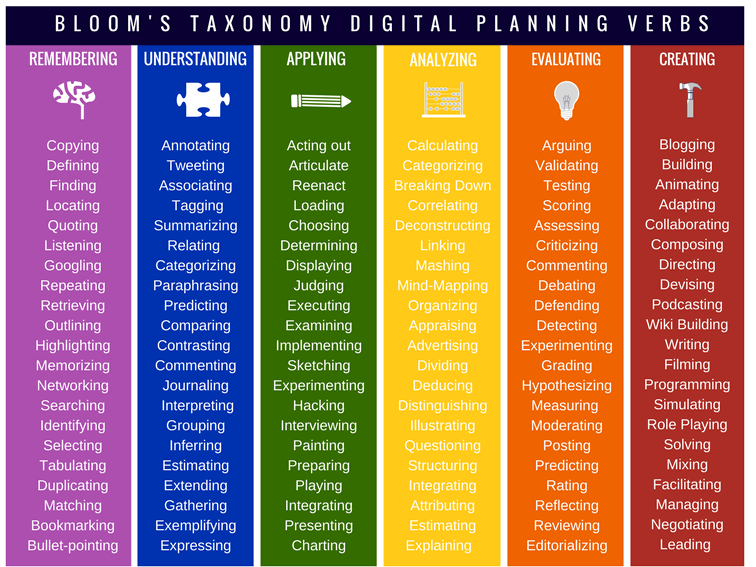
Bloom’s Taxonomy Is A Hierarchical Framework For Cognition And Learning Objectives
by TeachThought Staff
In one sentence, Bloom’s Taxonomy is a hierarchical ordering of cognitive skills that can, among countless other uses, help teachers teach, and students learn.
For example, Bloom’s Taxonomy can be used to:
create assessments
frame discussions
plan lessons (see 249 Bloom’s Taxonomy Verbs For Critical Thinking)
evaluate the complexity of assignments
design curriculum maps
develop online courses project-based learning (often through project-based learning ideas)
self-assessment
See How To Teach With Bloom’s Taxonomy for more reading.
A Brief History Of Bloom’s Taxonomy Revisions
Bloom’s Taxonomy was created by Benjamin Bloom in 1956, published as a kind of classification of learning outcomes and objectives that have, in the more than half-century since, been used for everything from framing digital tasks and evaluating apps to writing questions and assessments.
The original sequence of cognitive skills was Knowledge, Comprehension, Application, Analysis, Synthesis, and Evaluation. The framework was revised in 2001 by Lorin Anderson and David Krathwohl, yielding the revised Bloom’s Taxonomy. The most significant change to the Cognitive Domain was the removal of ‘Synthesis’ and the addition of ‘Creation’ as the highest level of Bloom’s Taxonomy. And being at the highest level, the implication is that it’s the most complex or demanding cognitive skill–or at least represents a kind of pinnacle for cognitive tasks.
See also 100 Bloom’s Taxonomy Verbs For Critical Thinking
How Bloom’s Taxonomy Is Useful For Teachers
In a separate post, we will cover exactly how teachers can use Bloom’s. There are many reasons for the popularity of Bloom’s Taxonomy (that likely deserve an article of their own to explore). For now, it’s clear that many educators love Bloom’s because, among other virtues, it gives them a way to think about their teaching—and the subsequent learning of their students.
As mentioned above, the framework can be used to create assessments, evaluate the complexity of assignments, increase the rigor of a lesson, simplify an activity to help personalize learning, design a summative assessment, plan project-based learning, frame a group discussion, and more. Because it simply provides an order for cognitive behaviors, it can be applied to almost anything. (You can see one example here–Bloom’s Taxonomy with common digital tasks.)
The image above visually demonstrates the levels of Bloom’s Taxonomy as a spectrum rather than a hierarchy, allowing room for the ‘power verbs’ that can act as synonyms (and thus activity ideas) for teachers planning lessons and units.
There are six levels in Bloom’s Taxonomy.
See also How To Write Lesson Objectives Using Bloom’s Taxonomy
The 6 Levels of Bloom’s Taxonomy
1. The first level is to Remember.
Example activities at the Remembering level: memorize a poem, recall state capitals, remember math formulas
2. The second level is to Understand.
Example activities at the Understanding level: organize the animal kingdom based on a given framework, illustrate the difference between a rectangle and a square, summarize the plot of a simple story
3. The third level is to Apply.
Example activities at the Application level: use a formula to solve a problem, select a design to meet a purpose, reconstruct the passage of a new law through a given government/system
4. The fourth level is to Analyze.
Example activities at the Analysis level: identify the ‘parts of’ democracy, explain how the steps of the scientific process work together, identify why a machine isn’t working
5. The fifth level is to Evaluate.
Example activities at the Evaluation level: make a judgment regarding an ethical dilemma, interpret the significance of a given law of physics, illustrate the relative value of technological innovation in a specific setting—a tool that helps recover topsoil farming, for example.
6. The sixth and highest level is to Create.
Example activities at the Creation level: design a new solution to an ‘old’ problem that honors/acknowledges the previous failures, delete the least useful arguments in a persuasive essay, write a poem based on a given theme and tone
